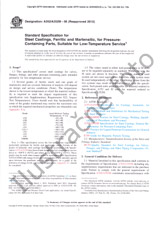Potrebujeme váš súhlas na využitie jednotlivých dát, aby sa vám okrem iného mohli ukazovať informácie týkajúce sa vašich záujmov. Súhlas udelíte kliknutím na tlačidlo „OK“.
ASTM D7897-18
Standard Practice for Laboratory Soiling and Weathering of Roofing Materials to Simulate Effects of Natural Exposure on Solar Reflectance and Thermal Emittance
NORMA vydaná dňa 15.3.2018
Informácie o norme:
Označenie normy: ASTM D7897-18
Poznámka: NEPLATNÁ
Dátum vydania normy: 15.3.2018
Kód tovaru: NS-853691
Počet strán: 10
Približná hmotnosť: 30 g (0.07 libier)
Krajina: Americká technická norma
Kategória: Technické normy ASTM
Kategórie - podobné normy:
Anotácia textu normy ASTM D7897-18 :
Keywords:
dust, laboratory, organic matter, roofing, salt, simulated field exposure, soiling, solar energy, solar reflectance, soot, thermal emittance, thermal radiation, weathering,, ICS Number Code 91.060.20 (Roofs)
Doplňujúce informácie
| Significance and Use | ||||||||||
|
5.1 The solar reflectance of a building envelope surface affects surface temperature and near-surface ambient air temperature. Surfaces with low solar reflectance absorb a high fraction of the incoming solar energy. Sunlight absorbed by a roof or by other building envelope surfaces can be conducted into the building, increasing cooling load and decreasing heating load in a conditioned building, or raising indoor temperature in an unconditioned building. It can also warm the outside air by convection. Determination of solar reflectance can help designers and consumers choose appropriate materials for their buildings and communities. 5.1.1 The solar reflectance of a new building envelope surface often changes within one to two years through deposition and retention of soot and dust; microbiological growth; exposure to sunlight, precipitation, and dew; and other processes of soiling and weathering. For example, light-colored “cool” envelope surfaces with high initial reflectance can experience substantial reflectance loss as they are covered with dark soiling agents. Current product rating programs require roofing manufacturers to report values of solar reflectance and thermal emittance measured after three years of natural exposure 5.2 Thermal emittance describes the efficiency with which a surface exchanges thermal radiation with its environment. High thermal emittance enhances the ability of a surface to stay cool in the sun. The thermal emittance of a bare metal surface is initially low, and often increases as it is soiled or oxidized 5.3 This practice allows measurement of the solar reflectance and thermal emittance of a roofing specimen after the application of the simulated field exposure. 5.4 This practice is intended to be referenced by another standard, such as ANSI/CRRC S100, that specifies practices for specimen selection and methods for radiative measurement. |
||||||||||
| 1. Scope | ||||||||||
|
1.1 Practice D7897 applies to simulation of the effects of field exposure on the solar reflectance and thermal emittance of roof surface materials including but not limited to field-applied coatings, factory-applied coatings, single-ply membranes, modified bitumen products, shingles, tiles, and metal products. The solar reflectance and thermal emittance of roof surfacing materials can be changed by exposure to the outdoor environment. These changes are caused by three factors: deposition and retention of airborne pollutants; microbiological growth; and changes in physical or chemical properties. This practice applies to simulation of changes in solar reflectance and thermal emittance induced by deposition and retention of airborne pollutants and, to a limited extent, changes caused by microbiological growth. 1.2 This standard does not purport to address all of the safety concerns, if any, associated with its use. It is the responsibility of the user of this standard to establish appropriate safety, health, and environmental practices and determine the applicability of regulatory limitations prior to use. 1.3 This international standard was developed in accordance with internationally recognized principles on standardization established in the Decision on Principles for the Development of International Standards, Guides and Recommendations issued by the World Trade Organization Technical Barriers to Trade (TBT) Committee. |
||||||||||
| 2. Referenced Documents | ||||||||||
|



 Cookies
Cookies
